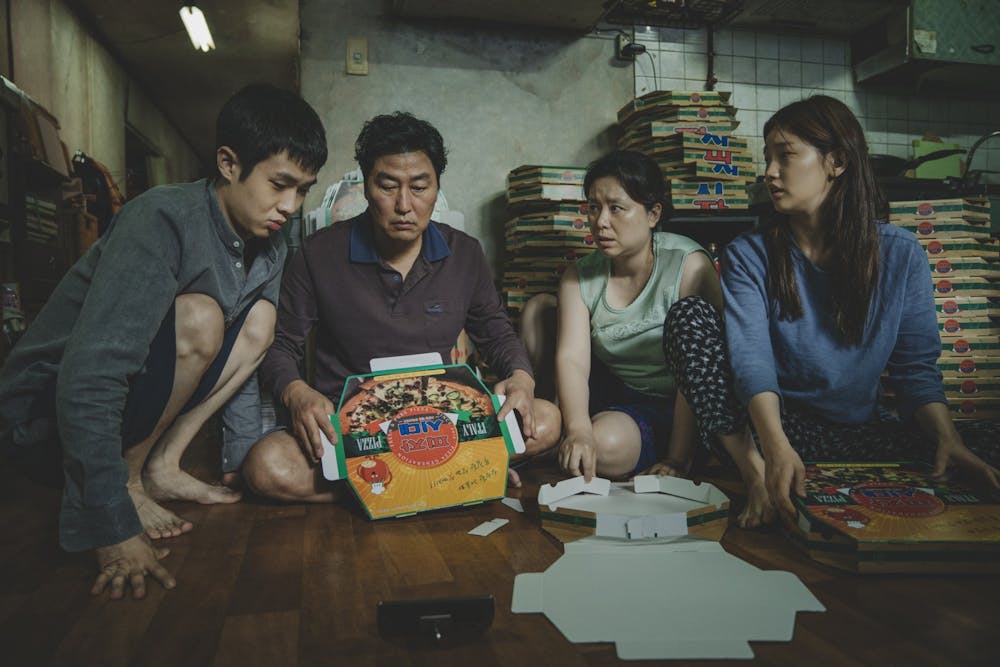Sweeping awards in four categories and rewriting the history books at the 92nd Academy Awards, Bong Joon–ho’s Parasite gave us a lot to feel good about. On its way to becoming the first non–English language film to win Best Picture, Parasite also picked up wins for Best Original Screenplay, Best International Feature Film, and Best Director—and now has the distinct honor of being the first South Korean film to win anything at the Academy Awards. Yet, the circus of luxury and upper–class opulence that has inevitably accompanied Parasite’s fairytale journey in awards season is a strange, ironic reminder of the very horrors the film satirizes.
I am definitely not suggesting that we should mourn each award Parasite wins, melt all the statuettes and trophies, and sell the gold off to rescue poor father Kim Ki–taek who is still probably languishing in the mansion’s basement. Parasite is a great film, and it is deservingly receiving praise and accolades.
However, amid all the confetti and celebrations, the themes of class inequalities and segregation explored in Parasite seem to grow with greater irony. The film will soon have to reckon with itself.
A film partially set in dingy basement homes, Parasite is celebrated in grand, palatial theaters—from Cannes to Los Angeles. While the story is a narrative of haves and have–nots, the film is showered with accolades at a ceremony like the Academy Awards—a night of red carpets and celebrities tottering around in expensive gowns and tuxedos. This year, directing and acting nominees each received a gift bag from a non–Academy–affiliated market company with around 80 items inside—including a pass for a 12–day yacht cruise, a gold–plated vape pen, and “philanthropic” items like a “cleanser that supports showers for the homeless”—carrying a total value of $225,000.

Cinema is intimately entangled with the worlds of class and privilege. Parasite, for example, was produced by CJ ENM, a South Korean conglomerate and one of the country’s chaebols—large businesses that are owned and run by some of the nation’s wealthiest families. The wealth stays within families, passed down from generation to generation. Socioeconomic class is so fixed to family—an idea that resonates throughout the film.
Some of the themes in Parasite have been explored in works like Us (2019), The Florida Project (2017), and recent Palme d’Or winners, the Japanese Shoplifters (2018) and the Swedish The Square (2017). Parasite is also reminiscent of the short story by Ursula Le Guin, "The Ones Who Walk Away from the Omelas" (which is about a child... in a basement).
A film like Parasite comes along, and begets the question—how has cinema acted in ways that are... parasitic?
Think about how so much of cinema is an audience sitting in the air–conditioned comfort of a theater, watching the flickering images of some of the world’s most oppressed, impoverished and displaced. Cinema has been powerful in highlighting these stories, shining a light on places and people languishing in the dark, and shaking institutions and others into action—but cinema has not been innocent either.
To his credit, Bong smartly wove a self-deprecating, self–conscious streak into the film, about art and the art world. In Parasite, the sister, Kim Ki–jeong, picks up the language of “art therapy” off the internet, and then glibly ad–libs her way into a job as an art therapist for the little son, Da–song in the rich family’s household. In another scene, the mother of the Park family stands in front of Da–song’s painting and waxes lyrical about it. These self–reflexive moments spoof art—but also indict art as possessing a certain “artifice” that becomes particularly pronounced during awards season.
Darker still, the mirroring, long, rectangular windows found in both the lower–class Kims’ and upper–class Parks’ family homes are precisely framed head–on to the camera. The diegetic, onscreen rectangular windows are juxtaposed against the larger rectangle of our cinematic screen—and the inequalities enclosed in the former gesture towards the inequalities embedded in the latter. The viewer is implicated with a certain politics of seeing and of contemplating misery at a comfortable distance.
Yet, Parasite is cautious not to take sides. Bong, in his director’s statement, writes, “This film is: a comedy without clowns, a tragedy without villains…” Parasite is a film where there are neither clear protagonists nor antagonists, criminals nor saints. No one is guilty—or perhaps, all are guilty.

Parasite’s characters and situations are not merely relegated to the fringes of physical peripheries of a country, nor even confined to the bellows of South Korean society. The damning proclamation of Parasite is that its world is right here: at our local pizza chain, on our streets, in the floors above us, in the basement... in the people whom we pass by, and in the people who pass us by.
Parasite’s very damning proclamation is also its most hopeful proposition: if the inequalities of society take place at such proximity, in such a compression of space, then help cannot, and should not, feel so far. Without airbrushing over the complex mechanisms of class, capitalism and society—many of which produced the very horrors that Parasite conjured—I think that the film, at the very least, pushes us into a new awareness.

